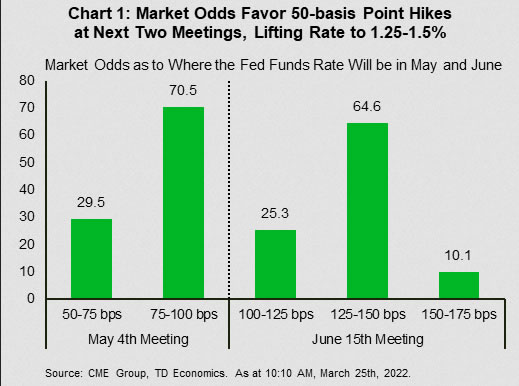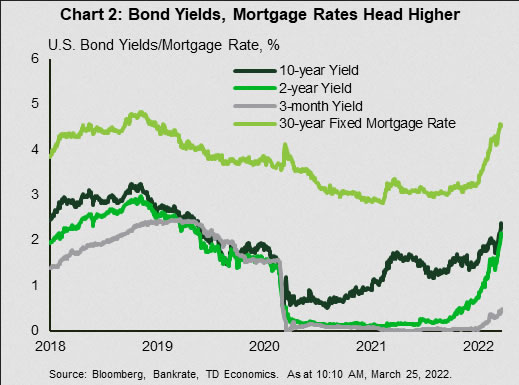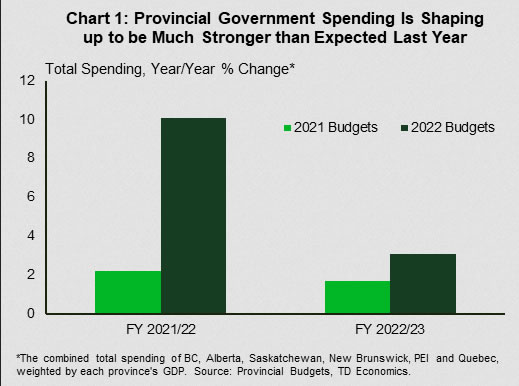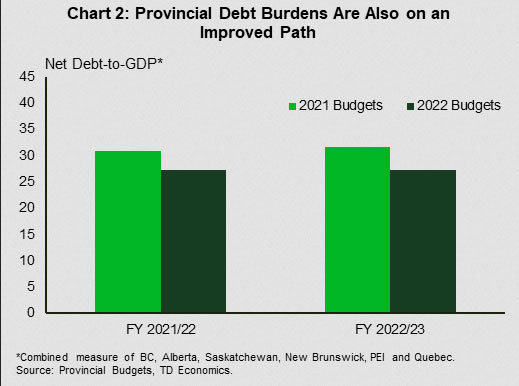U.S. Highlights
- In a carefully crafted speech this week in D.C., Fed Chair Powell reaffirmed the Fed’s keenness for a more aggressive removal of monetary stimulus in order to restore price stability.
- Powell highlighted the potential for the Fed to go with hikes larger than 25 basis points (bps) if deemed appropriate. Market odds now heavily favor 50 bps hikes at the next two FOMC meetings in May and June.
- On the data front, both new single-family home sales and pending (existing) home sales pulled back in February.
Canadian Highlights
- Bond yields shot higher this week, building on prior gains. The Canadian dollar also moved higher for the second straight week as past flight-to-safety moves unwound somewhat.
- Saskatchewan, New Brunswick and Quebec released budgets this week, making a total of six provinces that have reported. Fiscal positions have turned out to be much better than anticipated at this time last year, and provincial government spending should be supportive of growth in 2022.
- Stealing the fiscal spotlight was the new partnership between the federal Liberals and NDP. The upshot is that both Liberal and NDP platform promises could be pushed through in the House, paving the way for new spending.
U.S. – Fed’s Focus Tilts Squarely on Restoring Price Stability
If last week’s Fed rate hike (and a sharp move up in the number of future expected hikes among FOMC members) left any doubt about the Fed’s transition to a more hawkish stance, Powell’s remarks this week are likely to have sealed the deal. There was no shortage of Fed speeches to parse, in a week that didn’t have much in the way of data.
The most noteworthy speech was Fed Chair Powell’s remarks in D.C. on Monday. Reading carefully crafted remarks, Powell recognized that the labor market is strong and still has “substantial momentum”. Further driving home his point, last week’s jobless claims fell to the lowest level since 1969. Powell also noted that inflation is “much too high”, and touched on the fallout from the Russia-Ukraine conflict, which will put additional upward price pressure through several key commodities, including crude oil. The price of the latter is up from last week and is holding near $110 per barrel at time of writing – a level that is broadly in line with our recent forecast (see here). Powell also emphasized that the path of inflation remains uncertain. He pointed out the potential for more COVID-related supply chain disruptions out of China, where a rise in Covid infections led to the lockdown of another major city of nine million people this week.
On the monetary policy response, Chair Powell noted that the Fed would not assume significant near-term supply-side relief on inflation but would instead be looking for actual progress on the ground. This was followed by more hawkish comments regarding the size of rate hikes, with the Chair highlighting the potential for the Fed to go with hikes larger than 25 basis points (bps) if deemed appropriate. Powell went further, stating that if the Fed determines the need to “tighten beyond common measures of neutral and into a more restrictive stance”, it would do that as well. This was already shown in the Fed’s updated dot plot, which had a median projected policy rate of 2.8% in 2023-24, above the long-run rate of 2.4%.
Several other Fed officials, including Mester, Daly, and Evans, echoed the hawkish stance by showing more comfort with rate hikes larger than a quarter point. It comes as no surprise then that market odds are now heavily favoring 50 bps hikes at the next two policy meetings (Chart 1). Bond yields and mortgage rates, meanwhile, continued to head higher (Chart 2). Thirty-year mortgage rates rose above 4.5% this week – a sharp increase from a little over 3% at the start of the year. Higher interest rates will take some steam out of housing demand this year, with this week’s declines in new and pending home sales for the month of February not entirely surprising. Higher borrowing costs are part of the reason why we expect the housing market to cool this year. For more on our housing outlook see here.
The bottom line is that the Fed is behind the curve on inflation, and now needs to take stronger steps to rein it in. While this also increases the chances of policy error, the Fed has reaffirmed its keenness for a more aggressive removal of monetary stimulus to restore price stability.
Canada – Fiscal Developments Take the Stage
Oil prices continued to be volatile although as of writing, are on track to end the week higher. Meanwhile, while bond yields continued their rise this week. On the yield front, central bank hawkishness has been driving yields higher across the curve this month, although more so at the front end. The loonie has also joined the fray, rising further this week as earlier flight-to-safety flows reverse. It is has risen about two cents since mid-March.
This week, Saskatchewan, New Brunswick, and Quebec released their budgets for the upcoming fiscal year. Six provinces have now reported, with Alberta, B.C. and PEI released earlier. Although we are missing Ontario, some themes are beginning to emerge. First, provinces mostly avoided major new revenue initiatives, although New Brunswick is introducing new tax relief measures, while Saskatchewan is broadening its tax base by adding the PST to admission and entertainment charges.
Second, election cycles matter, as Quebec is delivering direct cash payments to most of its population ahead of its October election. Third, government spending will likely be growth-supportive in 2022, as the combined, GDP weighted, expenditures of all six provinces is estimated to have grown by 10% in FY 2021/22 (Chart 1). This means that spending strength likely extended into the early part of this year, which should help economies post above-trend growth (see latest Provincial Economic Forecast). Aggregate expenditure growth is forecast to slow to 3% in the upcoming fiscal year, but inflation is also expected to ease moving forward, which will make inflation-adjusted spending look better. Finally, capital spending is featuring prominently in budgets so far.
Governments are in a much better fiscal position compared to expectations imbedded in last year’s budgets. The combined deficit for FY 2021/22 of the six provinces reporting so far amounts to about $9 billion – $30 billion below what was expected last year. As a result, aggregate net debt-to-GDP is also lower (Chart 2). This picture may ultimately turn out even better for Alberta and Saskatchewan, given the modest commodity price profiles built into their budgets.
Despite the flurry of budgets released this week, the more eye-catching fiscal development was the new partnership between the federal Liberals and NDP. The NDP will back Liberal platform plans, including a tax on banks and insurers, and action on housing. In turn the NDP wants to add an income-based dental care program and a national pharmacare program. Perhaps the biggest takeaway here is that significant new spending could be forthcoming in the federal budget, expected in April. While this could prove growth supportive, it will do little to quell inflation, putting more onus on the Bank of Canada to rein it in.






 Signal2forex.com - Best Forex robots and signals
Signal2forex.com - Best Forex robots and signals




